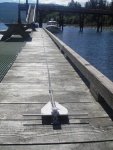Hi all,
After having the anchor and chain on Osprey for only a month I noticed some ugly interaction between the galvanized chain and the stainless bow cleat. It seems there has been a transfer of metal or metal oxide to the cleat. Rather unattractive.
I'm looking for advice. Are ya'll using some other type of chain or can this be somehow avoided? I'm also interested in knowing what is best to use for a quick connection twixt rope and chain.
Thanks in advance for your sage replies.
After having the anchor and chain on Osprey for only a month I noticed some ugly interaction between the galvanized chain and the stainless bow cleat. It seems there has been a transfer of metal or metal oxide to the cleat. Rather unattractive.
I'm looking for advice. Are ya'll using some other type of chain or can this be somehow avoided? I'm also interested in knowing what is best to use for a quick connection twixt rope and chain.
Thanks in advance for your sage replies.

